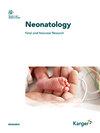Prognosticating the Outcomes of HIE with Certainty: Mission Impossible? - Commentary on "Clinical Prediction Models and Predictors for Death or Adverse Neurodevelopmental Outcome in Term Newborns with Hypoxic Ischemic Encephalopathy: A Systematic Review of the Literature".
IF 3
3区 医学
Q1 PEDIATRICS
引用次数: 0
确定HIE预后:不可能的任务?-“缺氧缺血性脑病足月新生儿死亡或不良神经发育结果的临床预测模型和预测因子:文献的系统回顾”的评论。
本文章由计算机程序翻译,如有差异,请以英文原文为准。
求助全文
约1分钟内获得全文
求助全文
来源期刊

Neonatology
医学-小儿科
CiteScore
0.60
自引率
4.00%
发文量
91
审稿时长
6-12 weeks
期刊介绍:
This highly respected and frequently cited journal is a prime source of information in the area of fetal and neonatal research. Original papers present research on all aspects of neonatology, fetal medicine and developmental biology. These papers encompass both basic science and clinical research including randomized trials, observational studies and epidemiology. Basic science research covers molecular biology, molecular genetics, physiology, biochemistry and pharmacology in fetal and neonatal life. In addition to the classic features the journal accepts papers for the sections Research Briefings and Sources of Neonatal Medicine (historical pieces). Papers reporting results of animal studies should be based upon hypotheses that relate to developmental processes or disorders in the human fetus or neonate.
 求助内容:
求助内容: 应助结果提醒方式:
应助结果提醒方式:


